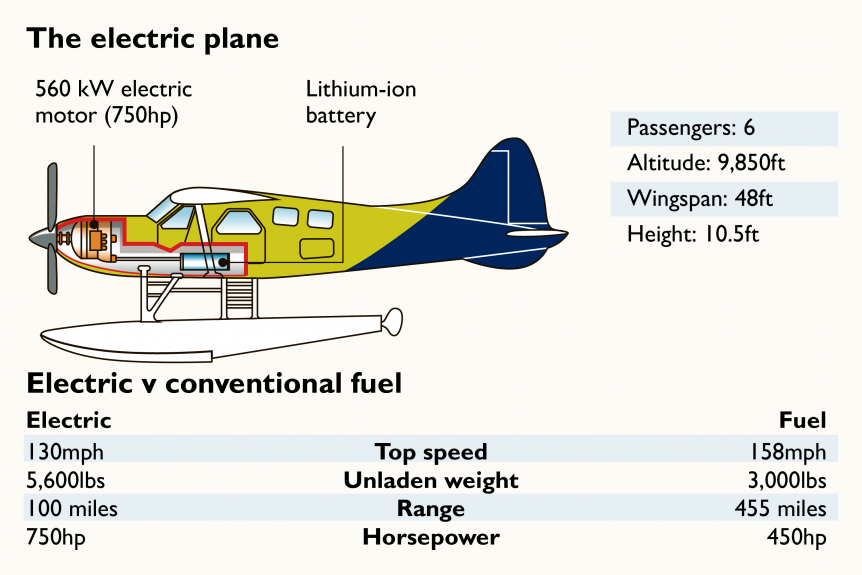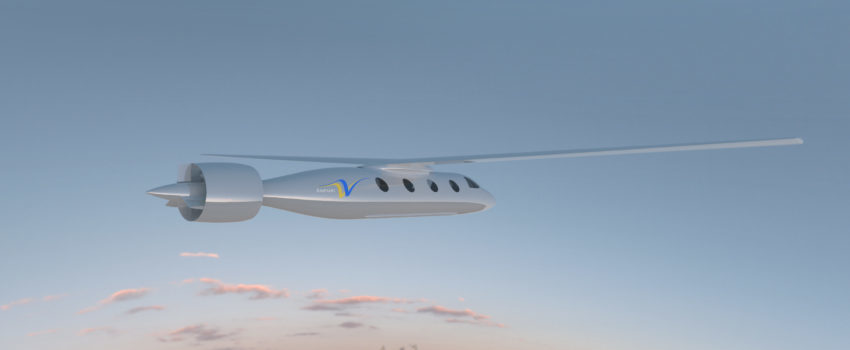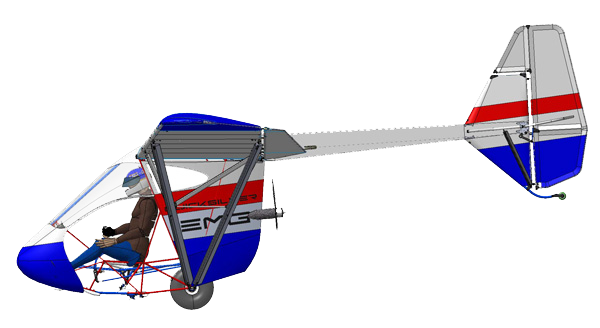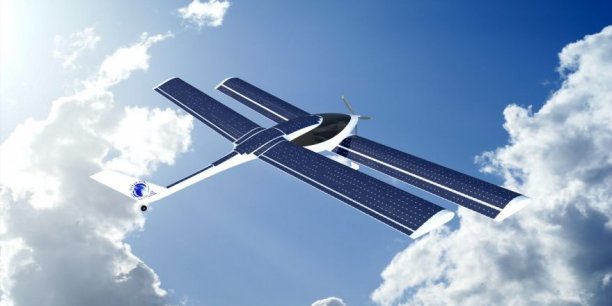Pie Aeronefs, a small team of dedicated builders in Switzerland is putting the finishing touches on the UR-1, a V-tailed, battery-winged electric racer expected to fly in next Air Race E series. “Marc Umbricht’s vision is to create a 4-seater general aviation electric aircraft that shall equal or surpass the performances of standard piston engine aeroplanes. This new generation aircraft will bring a viable and sustainable alternative on the general aviation market.” To achieve this ultimate goal, the Pie Aeronefs team has a series of iterative designs to explore, starting with a single-seat eRacer. The small aircraft development firm in La Sarraz, Switzerland is on track to complete the airframe of its UR-1 Air Race E machine soon. 12 Battery Packs Innovative in the extreme, the small craft will store 12 in-series 10-kilogram (22-pound) battery packs in its wings. Each 55-Volt pack stores 1.15 kilowatt hours of electricity. The 13-member team chose lithium-ion polymer cells for their battery packs because …
Harbor Air’s eBeaver, MagniX’s Motor, H55’s Batteries
In our last blog entry, we discussed a three-partner enterprise with an American airframe propelled by a French motor powered by British batteries. In this round, we have a Canadian airframe powered by an Australian/American motor driven by Swiss batteries. These international collaborations may pay off in big ways. Datelined Vancouver, B.C., Everett, WA, and Sion, Switzerland, the joint press release shows a strong and well-organized partnership in action. “Harbour Air, North America’s largest seaplane airline; magniX the company powering the electric aviation revolution; and H55, the spin off from Solar Impulse, producing highly efficient certified battery packs, announced a partnership to certify the world’s first electric Beaver (eBeaver) commuter airplane through a supplemental type certificate (STC) program.” H55 is a part, also, of the Solar Impulse Foundation, organized to promote “1000+ efficient and profitable solutions to protect the environment.” Their collaboration with Harbour Air and magniX is one of those solutions. Even though a small airline (40 aircraft) flying …
Ampaire Flies Hybrid Test Bed
Ampaire, a tech startup based in California, announces, “Our mission is to be the world’s most trusted developer of practical, compelling electric aircraft from short-haul cargo to supersonic passenger transport.” They also claim to have demonstrated the “highest-capacity electric aircraft ever flown” last Thursday, June 5th at Camarillo, California. The company hopes to “have regular commercial service for passengers and cargo as soon as 2021.” Using a Cessna 337 Skymaster was a canny move for the young firm, giving them ample weight-carrying ability to have a petrol engine in the nose and a dual-Emrax motor system behind the cabin and between the twin tail booms. The push-pull arrangement adds to engine-out safety with no assymetrical thrust as on a conventional light twin. The Skymaster’s six-passenger cabin will enable profitable flights for charter work. A standard 337 has an empty weight of 2,655 pounds and a payload of 1,745 pounds for a gross weight of 4,400 pounds. With four to six …
A 24-Volt Airplane Motor?
One of the big surprises in last month’s webinar hosted by the EAA and presented by Brian Carpenter of Rainbow Aviation Services/Adventure Aviation was the 24-Volt motor being developed for the EMG-6 ultralight motorglider. High and Low Voltages Many, if not most of the electric motors flying on existing craft are higher voltage units. For sake of an off-handed definition, we’ll divide low and high at below and above 50 Volts, something OSHA delineates in its regulation 29 CFR 1910.303(g)(2)(i), which “generally requires “’live parts of electric equipment operating at 50 volts or more’ to be ‘guarded against accidental contact by use of approved cabinets or other forms of approved enclosures’ or by other specified means.” In its explanation, the Occupational Safety and Health Administration “considers all voltages of 50 volts or above to be hazardous. Electric current, not voltage, passing through the human body causes injury….” And it really doesn’t take much amperage to take a person to the …
A Solar-Algae Hybrid for an Atlantic Crossing
Henri Mignet was never quite able to master an airplane with three-axis controls, and built at least seven flawed attempts at simplified controlled flight. His seminal try, the HM-8 Pou de Ciel (literally, Louse of the Sky, or more familiarly, Flying Flea) became first a matter of celebration for amateur aviators and then a cause of scandal, being banned in Britain following a series of fatal crashes. The “formula”, as proponents called Mignet’s tandem wing configuration, was sorted out after wind tunnel tests in England and America uncovered the flaw that caused the craft to pitch down in an unrecoverable dive. (For a well-illustrated history of Mignet’s design, see Henri Mignet and his Flying Fleas by Ken Ellis and Geoff Jones. Although out of print, used copies are available at Alibris and Abe Books, at higher prices than your editor paid for his new copy 25 years ago.) Later models of the formula have proven to be safe, stable fliers, …
South America’s First Manned Electric Aircraft
Brazil and Paraguay join the few nations which have sent an electric aircraft into flight with the introduction of the Sora-e, an attractive two-seat light sport aircraft. The 8 meter (26.25 feet) wingspan plane incorporates a Slovenian motor, Korean batteries and an American propeller, giving it a truly international flavor. The two countries share a joint venture firm, Itaipu Binacional, building and developing the airplane and its future variants. Pesquisa FAPESP (Investigation Sao Paolo Research Foundation), an online magazine dealing with various sciences, announced the first flight of a new, two-seat, electric-powered airplane. The Sora-e’s initial flight will lead to a testing program that will eventually have the plane up for 90 minutes and reaching a cruising speed of 190 kilometers per hour (118 mph). Designed by ACS-Aviation of Sao Paolo and built by ACS and Paraguay’s Itaipu Binacional, Sora-e is an all-carbon-fiber machine with seemingly excellent visibility. https://www.youtube.com/watch?v=n-0E83jVLc4 The video shows the first test flight taking place at Hernandarias, …
Eurosport Exploring New Configurations
Unhappily, we missed seeing Tom Leite at this year’s Electric Aircraft Symposium. Happily, he was at Eurosport Aircraft, his company in Portugal, working on innovative new approaches to making electric and hybrid motor-gliding a reality. He also has a speedster that would give those who desire rapid transit a high-style alternative. As shown in the video from Aero Friedrichshafen, the Crossover will probably trend toward a simpler wing configuration, with a fixed span of 18 meters (59 feet) and flaperons that will replace the multiple flaps on the current short-span version being flown in test flights. It’s uncertain whether the current twin-motors that pop out of the sides of the extremely slender fuselage will be retained, but a new version of the Crossover will feature three power options. As shown at Aero 2014, the airplane has the two options outlined on opposite sides of the fuselage – the port side displaying the Rotax-powered version, with a carbon-fiber shaft transmitting power …
If You Have to Ask…
Binder Flugmotoren- & Flugzeugbau is a German firm specializing in high-end single and two-seat motorized sailplanes which offer outstanding performance. Their EB29d Elektro is a two-seater with winning lines and ways – as evidenced by their recent victories in European and American soaring contests. A self-launcher more intended for climbing and soaring than cross-country touring under power, the airplane shares some characteristics of operation and design with Lange’s Antares and Arcus series and some ASH models. The motor extends and retracts on a long stalk, for instance, and the batteries for power are contained in the wings. Binder’s EB28 and EB29 segelflugzeuge come in 25.3 meter (82.98 feet), 28.3 meter (92.82 feet), and 29.3 meter (96.10 feet) spans, easily reduced or extended with a set of exchangeable wingtips. Binder’s claim that “Now you can choose the optimum wing span for every weather, in order to fly at the front of the competition or to enjoy great pleasure of flight. This concept …
Sustainable Soaring
Glaser-Dirks Flugzeugbau, the German sailplane manufacturer, has introduced the DG-1001te, a two-seat, electric turbo craft that can sustain flight and even show a modest rate of climb, but is not capable of self-launching. The “turbo” designation is common on European craft that rely on a pop-up motor to maintain flight in unfavorable soaring conditions. Following an aero-tow or winch launch, the sustainer engine is used to allow “get-home mode” operation, or to maintain altitude while the pilot searches for areas of better lift. Until recently, single- and two-cylinder Solo two-stroke engines served on many applications. Electric motors are beginning to find favor, though, because of their ease of starting and the fact that their light weight and high power output counterbalance the added weight of batteries. The battery pack can be kept small because of the small power output required to keep sailplanes airborne – under five horsepower at best gliding speed for even large birds. Luka and Matija Znidarsic, …





